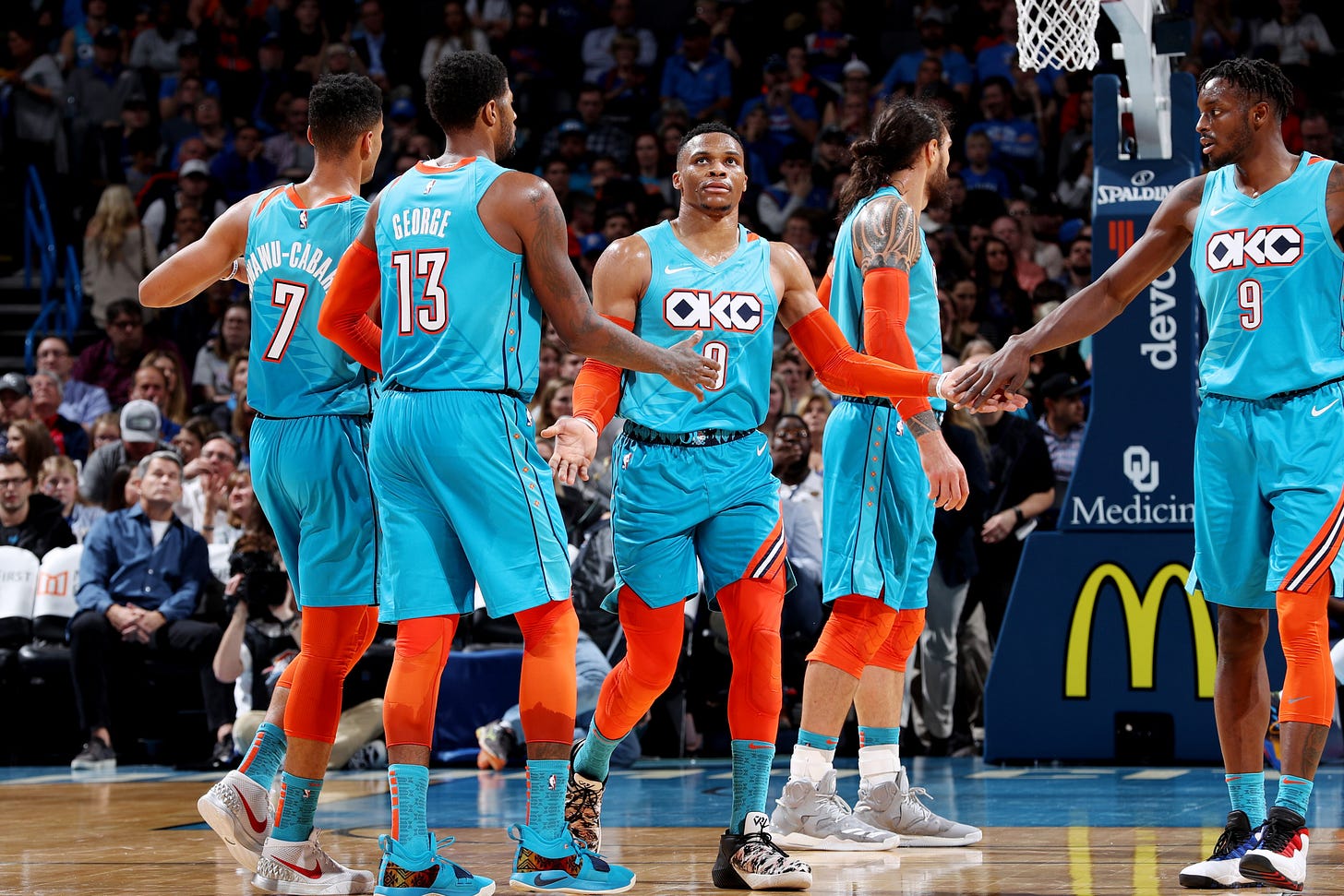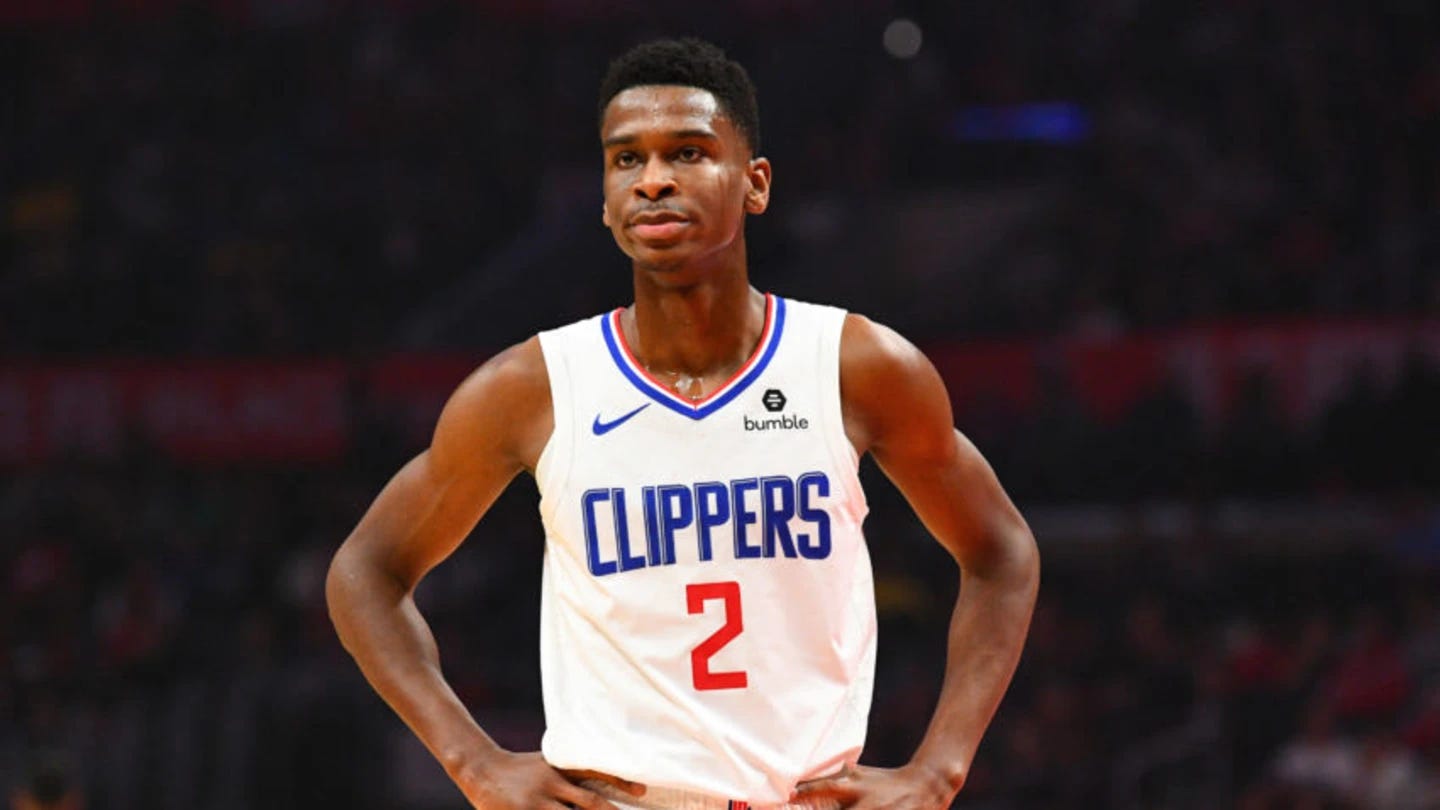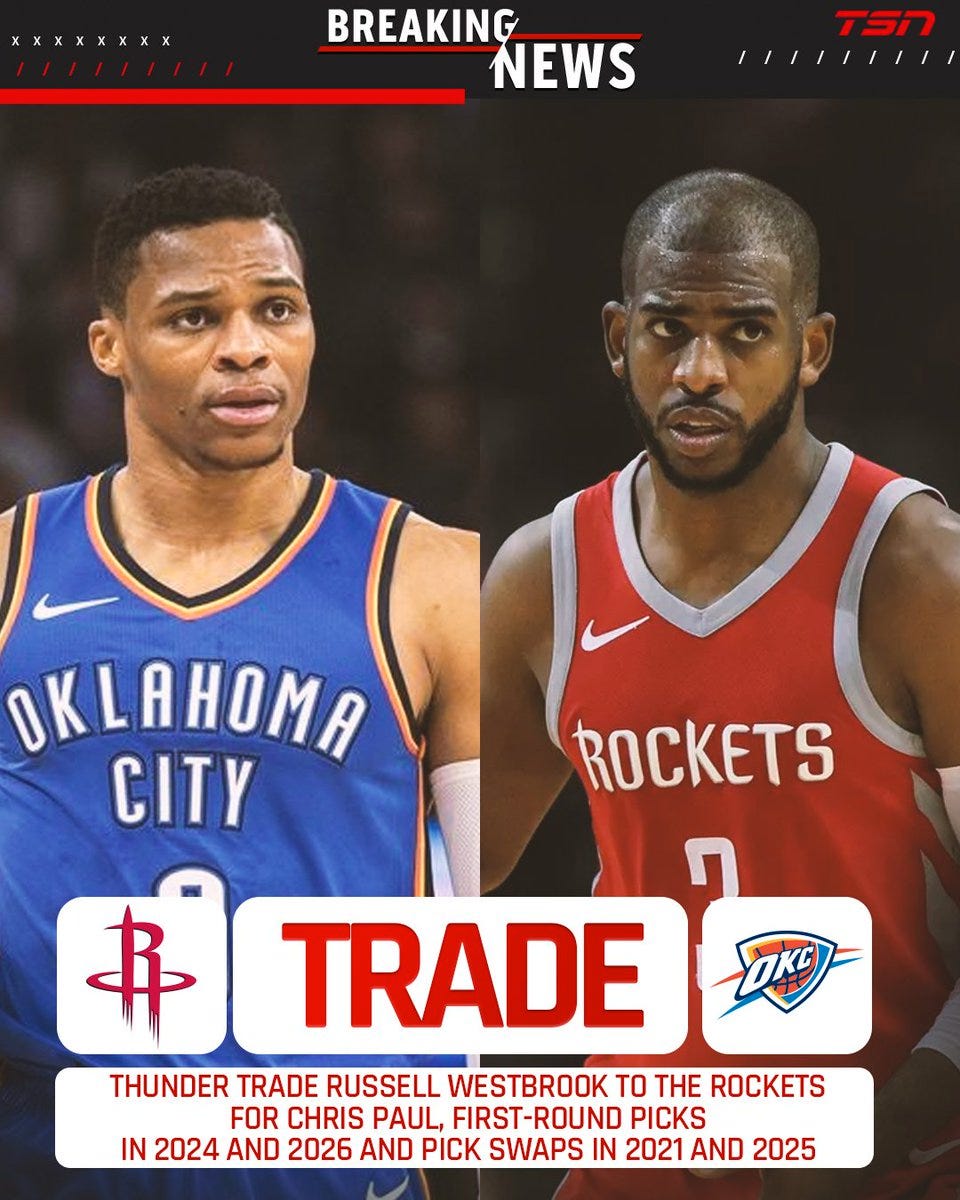If you’re searching for a shining example of how quickly the NBA moves, I recommend looking in tornado country. The Oklahoma City Thunder have lived about five full lives since decimating their roster in the summer of 2019.
After the death of the old guard came the birth of something new, something exciting for the Thunder. But when the initial novelty started to fade, seeds of doubt began to sprout— questions regarding whether the franchise was on the right path— only to die off when it became evident that we should have believed in what we saw in the first place, and that greatness was on the horizon after all.
Now, in 2024, OKC’s rapid ascension has the team being mentioned in the same breath as the NBA’s elite— actually, OKC has become one of the NBA’s elite.
How did this all happen? More importantly, how did it happen so quickly— and is Oklahoma City’s rise to the top of the NBA sustainable?
I. Starting Over
It’s July 2019. Oklahoma City just shipped All-NBA talent Paul George out west to LA, where he’ll join the Los Angeles Clippers.
Is this an admission of defeat?
Though George is coming off a career year in which he averaged 28 points per game and finished third in MVP voting, the Thunder suffered a crushing series loss in the first round of the 2019 playoffs. How crushing? Well, they got literally waved off the court by Damian Lillard in a moment we’re confident will be remembered and discussed years from now.
OKC’s loss to Portland in the first round of the playoffs marks the franchise’s third straight first-round exit. In response, the franchise sends George to Los Angeles in a move that Thunder General Manager Sam Presti wouldn’t call “mutual,” instead opting for “not adversarial.” Whatever the hell that means.
Regardless of what happened behind the scenes between George, Presti, and the rest of OKC’s front office, a new book is being written in The Big Friendly, which is, apparently, Oklahoma City’s nickname.
The return for PG13? Besides about 68 first-round draft picks, Oklahoma City will receive Shai Gilgeous-Alexander, the 11th overall pick in last year’s draft who showed a knack for weaseling his way through crowded paints and a coolness beyond his years during his rookie campaign.
Talk about a vote of confidence. SGA performed well enough in his rookie season to change his career outlook. Plus, being a lottery pick in a big market like Los Angeles is a role that already includes high expectations. But to then immediately become the centerpiece in a trade for an All-NBA, future Hall of Fame player? This raises the expectation ladder a few more rungs.
At least he’ll have Russell Westbrook, one of the best point guards of the 21st century, to mentor him on his journey to (hopeful) stardom.
Uh, ok, Chris Paul then. That’s good too.
II. Building
The 2019-20 Oklahoma City Thunder are one of the funniest NBA teams ever assembled. After trading away its two best players during the offseason for an unproven 21 year-old and an aging point guard (plus a bunch of picks) the Thunder got better. After going 49-33 the year prior, Oklahoma City went 44-28 in the COVID-shortened 2019-20 season.
Paul and Gilgeous-Alexander were on disparate ends of the “NBA career” spectrum when they crossed paths in OKC; Gilgeous-Alexander’s season was more proving ground while Paul’s veered redemption arc. SGA improved his scoring average from 10.8 to 19.0, his usage jumped almost five full percentage points, and—maybe most impressively— his efficiency stayed level even with the leap in workload. Paul, meanwhile, put together an All-NBA season and finished seventh in MVP voting.
Though coming from nearly opposite backgrounds, the guards meshed instantly (time machine moment: to this day, Paul literally chokes up when talking about his bond with Gilgeous-Alexander) and early returns on both trades look pretty damn good. Pretty, pretty, pretty, pretty damn good.
Though CP3 and SGA lead the charge, the Thunder’s unexpected success is a communal effort. Steven Adams and Nerlens Noel provide a tough frontcourt, Dennis Schroeder is a great change of pace guard off the bench, and Danillo Gallinari is singing a beautiful swan song.
Eventually, Oklahoma City’s season ends in a first-round exit again— this one took place in a bubble— but it feels completely different from the series loss to Portland. The aura surrounding the team is hopeful. It took a heroic James Harden block in Game 7 to down the Thunder, who exit the season with a future star point guard and a boatload of draft picks.
III. Delay in Construction
Fast forward to Fall 2022. Chris Pual is long gone, traded to Phoenix shortly after the 19-20 season. OKC is now coached by a guy no one has ever heard of, and he’s gone 46-108 in two seasons at the helm. Fans are getting restless with Sam Presti’s insistence on stockpiling draft picks instead of acquiring good players. Shai Gilgeous-Alexander has clear All-Star potential but his efficiency dropped considerably between years three and four, and OKC is still searching for his running mate (Josh Giddey looks solid but has a clear ceiling, and his lack of shooting will likely hamper his chances at being a real second star.)
Trade winds are also starting to bluster around SGA. Granted, those winds have been mostly manufactured by fans of big-name teams desperate to yank a young upstart star from a struggling small market, but… sometimes that’s how real trades start. With whispers. With gossip.
Sam Presti is forced to make a public statement clarifying that he, under no circumstance, plans on trading SGA.
In just two seasons, OKC’s situation went from promising to precarious. Winning 30% of your games in two seasons will do that. To compound the feelings of worry, number two overall draft pick Chet Holmgren will miss his entire rookie season with a broken foot that happened in a Pro-Am Game.
We know Chet has a long career ahead of him within our organization and the Oklahoma City community. One of the things that most impressed us during the process of selecting Chet was his determination and focus. We expect that same tenacity will carry him through this period of time as we work together and support him during his rehabilitation."
-Sam Presti
The 2021-22 season feels massively important for OKC— a third straight year in the NBA’s gutter would raise red flags up and down the organization— and it’s already off to a rough start. A huge SGA leap and some production from the other rookie, Jalen Williams out of Santa Clara, are paramount to keep OKC on track.
IV: Construction Resumes
Yeah, like that. Williams finished second in Rookie of the Year voting by averaging 14.1 points per game, shooting over 50% from the field, and grabbing 1.4 steals. SGA’S running mate has been found—potentially at the eleventh hour.
Speaking of Shai… he’s, like, the best point guard in the NBA now. In addition to averaging 31.4 points per game (fourth-most in the NBA) he posted career-highs in FG%, FT%, FTA, steals, blocks, minutes, true shooting, win shares, BPM, VORP, PER… you name it. A superstar was born this season and the league is taking note.
Oklahoma City finishes this season 40-42; under .500, sure, but the ship has been righted; SGA shed any and all questions about his ability to lead a team, Jalen Williams burst onto the scene quickly as a potential second star, Mark Daigneault has established himself as a smart and capable NBA coach, and a bunch of players that Presti took flyers on — Isaiah Joe, Kenrich Williams, Aaron Wiggins — produced valuable minutes for the team.
Of course a rebuild hinges on hitting the home runs like Shai Gilgeous-Alexander. But finding value on the scrap heap— late second round picks, waiver wire pickups, two-way contracts— is also incredibly important to filling out an elite team. The franchise cornerstones lay the foundation; they start the rebuilds. But the guys on the outskirts complete the rebuilds.
I’ll come clean; up until about this point— sometime during the 2022-23 season— I thought Sam Presti was a fraud. I believed his strategy of stockpiling picks was a gimmick that made him appear a managerial genius while also letting him get away with never having to make any decisions as GM. You can’t make all those picks, I thought, so why not just try to get good basketball players instead of obsessing over the idea of good basketball players?
But with Shai’s ascension to All-NBA player, Jalen Williams’ impact from day one, and the random role players producing on a nightly basis, I finally started to see the vision. I, like the rest of the NBA public, became convinced that OKC could reach contender status sometime in the future.
V: Built.
Never mind “sometime in the future",” OKC wants to win it all now. And by now I mean in 2024— hey, we finally made it to present day!
Last week, after beating the Phoenix Suns 118-110, Oklahoma City improved its record to 42-18 and maintained a grip on the Western Conference’s top seed. With about 20 games remaining in the regular season, OKC—despite its youth— is a real contender. Now. The Thunder are top five in offense and defense, first in 3PT%, and own a 23-13 versus teams over .500. Elite!
Good God, that was quick. How was that so quick?
Oh, right, this guy has arrived, too.
Chet Holmgren, after missing an entire season, has instantly become one of the most impressive rookies I have ever seen. 17.1 points, 7.8 rebounds, 2.6 blocks per game. 39.5% three-point shooter. He’s already a near-All Defense player and he’d be the clear Rookie of the Year if he wasn’t competing with the 12-foot tall basketball playing robot slash Gumby man. Physically, Holmgren is the archetype of the new NBA— impossibly coordinated for how tall he is, gliding down the court, confusing defenses (and viewers. I’m still trying to figure out how he does the things he does.)
Jalen Williams, meanwhile, is good at everything. He’s not a “future” star, he is a star. He will be remembered as one of the best draft picks of the Sam Presti era in OKC, and that list includes a couple of HOFers.
And the “flyer” guys that made last year’s OKC team so enjoyable? They’re still around too— Joe and Wiggins have both gotten better, refining their roles even more than last season.
INTERMISSION
Deep breath.
If it feels like OKC’s rebuild is moving at warp speed, you’re right. If it doesn’t feel like that, I need to become a better writer. Going from roster teardown to competitor in just five seasons is unprecedented, even in an NBA that moves at the breakneck pace it does in 2024. Of course, teams have built competitors overnight thanks to big name trades— just existing as the Los Angeles Lakers means you’re perpetually close to acquiring a star— but that’s what makes OKC’s path even more impressive: they didn’t do that.
Every impact player on this team was either drafted by OKC or signed by it; every player besides SGA, that is, who the team traded for. But even then, OKC didn’t trade for superstar SGA, it traded for rookie SGA. Unproven SGA. He became the player we know today within the confines of OKC’s system. Would he have become this player anywhere else? Maybe. But he didn’t— he did it as a Thunder.
I don’t think Sam Presti meant to recreate The Process (Sam Hinkie’s just so crazy it may work team-building strategy that was unleashed on Philadelphia in the 2010s) but he kind of did anyway. Philadelphia’s plan was, essentially, to be as bad as possible, gather as many assets as possible, and then improve massively, quickly.
Oklahoma City had one season between occupying the league’s dregs and having a legitimate shot at making the NBA Finals. That’s quick, massive improvement if you ask me. The quickness with which everything came together is why I went from calling Sam Presti a fraud to singing his praises as a GM. It all clicked at once.
The Prest-cess? The Pro-sti? I’ll workshop it.
VI: And Then?
To be determined.
Whether OKC wins a title with this team remains to be seen. I think they will— Chet Holmgren, Jalen Williams, Cason Wallace will all get exponentially better as the years pass by, and I can’t picture a world where both Chet and “JDub” aren’t multi-time All-Stars.
Even now, after building an incredibly talented young team, OKC has a stash of future draft picks. Now I understand the value of those picks; when your current roster stinks, picks don’t mean much to me. But now that OKC is competing, those picks can— and should— all be used as leverage for improving the team in the future.
A letdown is possible. Maybe everyone’s shooting percentages drop— this year’s Thunder is one of the best jump shooting teams of all time. Maybe teams figure out how to gameplan around OKC’s semi-lack of size. Maybe the team’s poor rebounding starts to rear its head. I don’t necessarily think any of those will happen, but rebuilds are unpredictable in the NBA. Things change in a hurry. Remember that show Destroy, Build, Destroy? That’s what roster building is like in the NBA.
Whatever path this team travels from here on out, its rise has been fascinating to see unfold especially when you consider OKC hasn’t really made a wrong move yet. It could have settled for Landry Shamet and Montrezl Harrell in the trade with Los Angeles instead of SGA. It could have preferred Jabari Smith Jr’s three-point proficiency and defensive versatility and drafted him instead of Chet Holmgren. It could have ignored Isaiah Joe and Aaron Wiggins and Lu Dort. It didn’t do any of those things!
Eventually something has to go wrong, but the more I examine Sam Presti’s moves throughout this rebuild, the more sure I am that OKC has the resources in place to bounce back from (most) managerial miscues.
It can’t be fun for other NBA franchises to forcast the next 15 years in the NBA having to compete against the Thunder.
Luckily I am not an NBA franchise. So I, personally, am going to enjoy it.
What I’m Listening to: Armand Hammer
This is, without hyperbole, one of the best rap songs I have ever heard. I cannot stop listening to it. Calling it a “rap song” might do it a disservice because I can’t recall any song sounding like this. It’s masterful. Listen to it, then listen again and again.
I had to let it all go so I could live in my head, again
Ransacking my mind but something hiding in the vents, ductwork, or worse
Something died in the walls like a church
Locked doors never had a key but you test the handle occasionally
God forbid it swing open
Attic stairs broken, don't go up there (Don't!)
From the windows I watch the diggers disappear in soft wet earth
Dinner served, I waited for my guests, long table set-billy woods
One More Thing: Feeling Good about Journalism?
This is not a feeling I’m used to. It’s a feeling that I hope I can experience more in the future, but I won’t hold my breath for that. It’s a feeling of optimism regarding journalism. Yes, I said it. Optimism about journalism. The scale is small— the field as a whole is surely fucked. But this article in the Guardian did make me pump my fist a few times, and that’s more positive a feeling than I can recall having about this medium in a long time.
A lot of this positivity is due to people signing up for these newsletters, co-ops, magazines, and projects. Knowing that people still want to read high-quality writing is very affirming. The creators aren’t to blame for all this crumbling. Neither are the readers. The hedge funds and investment groups that don’t actually care about quality journalism and just want to buy up newspapers/magazines/ media outlets and flip them for a profit? Yeah, those are the guys we should be mad at.
This shit is all crumbling, for the record. But I will sleep better knowing that all the smart, creative, hardworking people in this industry will come out of the rubble with middle fingers raised no matter what. Never stop, y’all.











Your ability to capture our collective mindset during each era was artful. Beautiful piece.
Destroy, Build, Destroy mentioned 👏